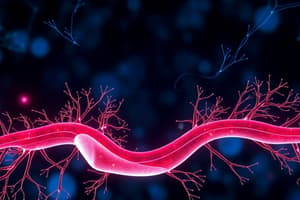Podcast
Questions and Answers
What is homeostasis?
What is homeostasis?
Homeostasis is the state of steady internal chemical and physical conditions maintained by living systems.
Provide an example of a positive feedback loop in a biological context.
Provide an example of a positive feedback loop in a biological context.
An example of a positive feedback loop is the onset of contractions in childbirth.
Explain how a negative feedback loop helps in maintaining blood glucose levels.
Explain how a negative feedback loop helps in maintaining blood glucose levels.
In a negative feedback loop, if blood glucose levels rise, it triggers a response to lower them back to the normal range to prevent diabetes.
What role does the hormone oxytocin play in a positive feedback loop during childbirth?
What role does the hormone oxytocin play in a positive feedback loop during childbirth?
How do positive feedback loops differ from negative feedback loops in terms of their outcomes?
How do positive feedback loops differ from negative feedback loops in terms of their outcomes?
What is the function of a sensor, also known as a receptor, in a feedback system?
What is the function of a sensor, also known as a receptor, in a feedback system?
Explain the concept of positive feedback in biological systems.
Explain the concept of positive feedback in biological systems.
Describe how negative feedback loops operate in biological systems.
Describe how negative feedback loops operate in biological systems.
Provide an example of a negative feedback loop in the human body and explain how it works.
Provide an example of a negative feedback loop in the human body and explain how it works.
How do negative feedback loops contribute to maintaining stability in biological systems?
How do negative feedback loops contribute to maintaining stability in biological systems?
Discuss the significance of negative feedback loops in temperature regulation.
Discuss the significance of negative feedback loops in temperature regulation.




